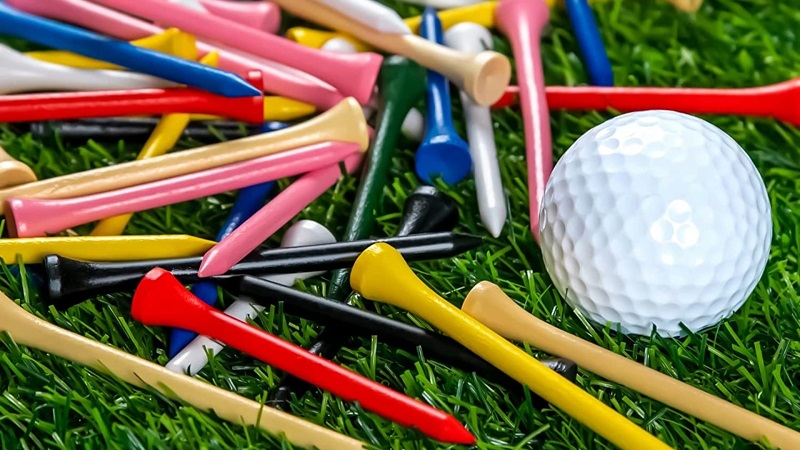Golf tees are essential accessories for every golfer, regardless of their skill level. They are used to elevate the golf ball for the initial drive, ensuring optimal contact with the club. In this article, we’ll compare wooden vs plastic golf tees, discussing the pros and cons of each to help you decide which one is better for your needs.
Wooden Tees
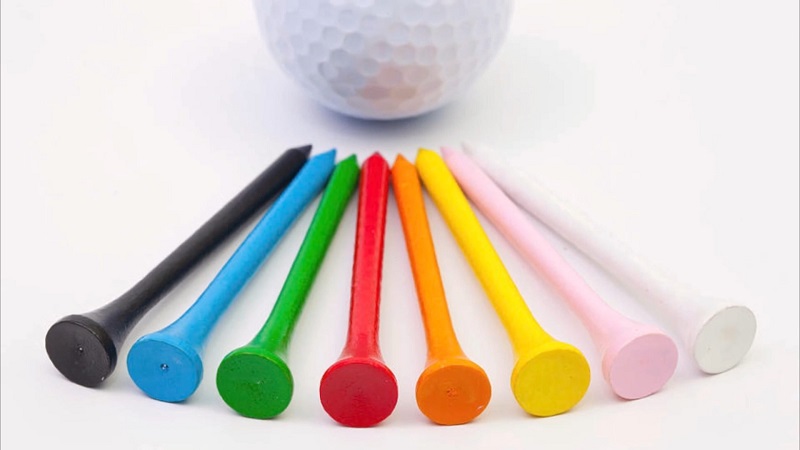
Wooden golf tees have been the traditional choice for golfers for many years. They are made from various types of wood, such as hardwood, bamboo, or birch, and come in various sizes and colors. Wooden tees provide golfers with a classic and natural feel during their swing, and they are often preferred due to their biodegradability and environmentally friendly qualities. With their timeless appearance and reliable function, it’s no wonder many golf enthusiasts continue to choose wooden tees as their preferred option on the links.
Advantages of Wooden Golf Tees
- Eco-friendly: Wooden tees are biodegradable and have a smaller environmental footprint compared to plastic tees.
- Better feel: Some golfers prefer the feel of wooden tees, claiming they provide a better connection between the club and the ball.
- Snapability: Wooden tees often break after a few swings, which can be seen as an advantage because it helps golfers recognize when they’re striking the ball incorrectly.
Disadvantages of Wooden Golf Tees
- Less durable: Wooden tees tend to break more easily than plastic tees, which means you’ll need to replace them more often.
- Limited options: Wooden tees typically come in fewer color and size options than plastic tees.
Plastic Tees
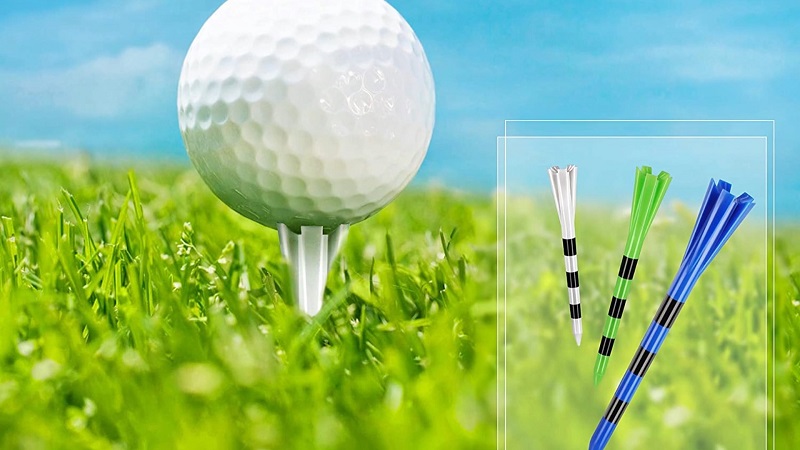
Plastic golf tees have become increasingly popular in the modern age of golfing; they are made from various types of plastic, such as ABS or polypropylene. Their durable plastic composition ensures that they can withstand multiple rounds of use and do not break as easily as traditional wooden tees. Furthermore, the variety of colors and sizes available allows golfers to customize their tees to their liking. While some may argue that plastic tees may not provide the same natural feel as wooden ones, the convenience and long-lasting nature of plastic tees cannot be overlooked.
Advantages of Plastic Golf Tees
- Durability: Plastic tees are generally more durable than wooden tees, meaning they can last longer and require less frequent replacement.
- More options: Plastic tees come in a wider variety of colors, sizes, and styles, giving golfers more options to choose from.
- Consistent performance: Some golfers find that plastic tees provide a more consistent tee height and ball contact compared to wooden tees.
Disadvantages of Plastic Golf Tees
- Environmental impact: Plastic tees are not biodegradable and can contribute to plastic waste in the environment.
- Less natural feel: Some golfers find that plastic tees don’t provide the same connection between the club and the ball as wooden tees do.
Comparing Wooden vs Plastic Tees
Wooden tees vs plastic tees both have their advantages. Wooden tees are the traditional choice and are generally more durable than plastic tees. However, plastic tees are easier to use and can be purchased in bulk for a lower cost. Considering how each type of tee will affect your performance and decision-making on the course is important.
Environmental Impact
For golfers who value their environmental impact. Unlike plastic tees that contribute to pollution and take hundreds of years to decompose, wooden tees are biodegradable and break down naturally. By opting for a more environmentally friendly option, golfers can reduce their ecological footprint while still enjoying the game they love. It’s an easy switch that can significantly impact the environment, making wooden tees the better choice for conscious golfers everywhere.
Performance
The performance of plastic and wooden tees can vary depending on personal preferences and individual golfing styles. Some golfers believe that wooden tees provide a better feel, while others prefer the consistency of plastic tees. Ultimately, it comes down to what works best for you and your golf game.
Durability
Plastic golf tees are generally more durable than wooden ones. They can withstand multiple swings without breaking, which means you won’t have to replace them as often. On the other hand, wooden tees can snap after just a few hits. Plastic tees might be the better option if you prioritize durability and want to save money in the long run.
Price
Regarding the price of golf tees, it’s important to consider both the initial cost and the long-term durability. While wooden tees may seem like the cheaper option at first, they also have a tendency to break easily, which could result in the need for more frequent replacements. On the other hand, plastic tees may be pricier initially, but their durability can save you money in the long run. Ultimately, it’s up to each individual golfer to decide which trade-offs and factors matter most when it comes to purchasing golf tees.
Ease of Use
Plastic tees offer a great option for golfers looking for added convenience in their tee. Being lightweight and easy to insert into the ground, plastic tees make for a much easier experience when attempting to tee off. While these may be less effective for long-distance shots due to their lack of grip on the ball, they are perfect for shorter distances or practice swings.
On the other hand, wooden tees require a bit more effort but provide a secure grip for shots requiring greater distance. Either way, each type of tee offers convenience and effectiveness depending on what is needed.
Wooden Golf Tees vs Plastic Golf Tees: Which Type is Better for Your Game?
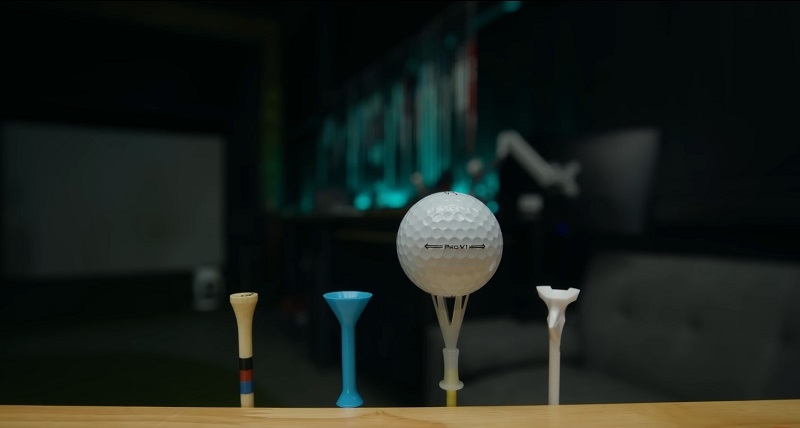
Deciding between plastic vs wooden golf tees is ultimately a personal preference. It depends on which type best fits your unique style, swing, and needs.
Plastic tees can be a great choice if you often play and want the most cost-effective option. On the other hand, if durability and stability are important, wooden tees may be your best bet.
Regardless of which type you choose, the important thing is to make sure you’re using comfortable and suitable tees for the shots you need to make. With this in mind, you can get the most out of your game regardless of what type of tee you use!
How to Choose the Right Tees for You?
Skill Level
Your skill level can play a role in determining which type of golf tee is best for you. As a beginner, wooden tees can help you improve your swing by breaking more easily upon impact. This immediate feedback can help you correct your mistakes and fine-tune your game. Meanwhile, seasoned golfers might prefer the durability and stability of plastic tees, which provide more consistent performance.
Personal Preferences
Ultimately, the choice between wooden vs plastic golf tees comes down to personal preference. You may need to try both types to determine which one feels better and provides the best performance for your unique golfing style.
After choosing your ideal golf tee, take your game to the next level by examining the Golf Clubs That Fueled Tiger Woods’ Victories.
How Much Distance Does A Tee Add?
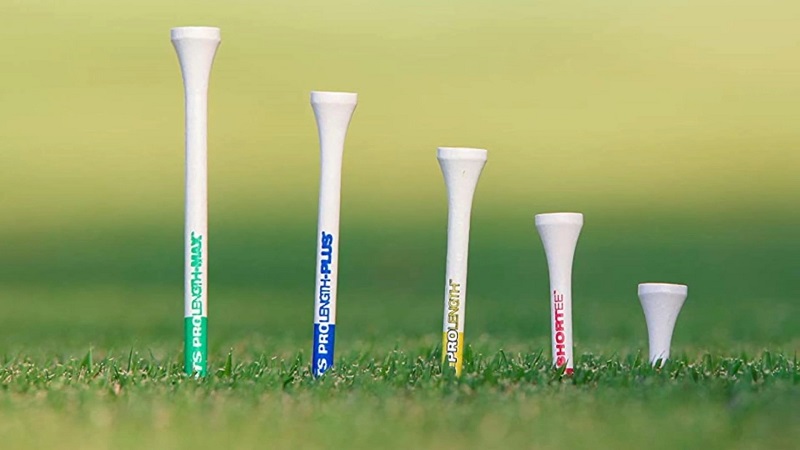
The distance added by using a golf tee depends on various factors, such as tee height, the golfer’s swing mechanics, and the type of club being used. While it’s difficult to provide an exact number, using a tee can help golfers achieve optimal launch conditions, improving their shots’ distance.
Tee Height: The tee height can significantly affect the distance a golfer can achieve. For drivers, using a higher tee can promote a higher launch angle and lower spin, which can lead to increased distance. Ideally, half of the ball should be above the top line of the clubface when teeing up with a driver. For irons and fairway woods, a lower tee height is preferred to maintain solid contact with the ball.
Swing Mechanics: A golfer’s swing mechanics also influence the distance gained when using a tee. A well-executed swing with a proper angle of attack can maximize distance. For drivers, a slightly upward angle of attack is ideal, as it can generate a higher launch angle and lower spin rates. Using a tee can make it easier for golfers to achieve this optimal angle of attack.
Club Type: The type of club being used can also influence the distance a tee adds. When using a driver or a fairway wood, a tee can help golfers achieve maximum distance by enabling them to strike the ball with the right launch conditions. For irons, the effect of a tee on distance is less significant, as golfers can typically achieve similar results by hitting off the turf with a clean strike.
Why Can’t You Get Balls In The Air?
Getting golf balls in the air can be frustrating for golfers of all skill levels. There are several common reasons why golfers might have difficulty achieving the desired ball flight. Some of these reasons include the following:
- Improper Club Selection: Using clubs with insufficient lofts, such as low-lofted irons or a driver, can make it more difficult to get the ball airborne, particularly for beginners or golfers with slower swing speeds. Opting for a club with more loft, like a higher-numbered iron, hybrid, or fairway wood, can help get the ball in the air more easily.
- Ball Position: Incorrect ball position in the golfer’s stance can lead to poor ball striking and difficulty getting the ball airborne. For irons, the ball should generally be positioned near the center of the stance, while for drivers, it should be closer to the front foot. Ensuring the correct ball position can help promote a better angle of attack and improve launch conditions.
- Hitting Down on the Ball: Many golfers mistakenly believe they need to “scoop” or “lift” the ball into the air, causing them to lean back and attempt to hit up on the ball. This can result in thin or “topped” shots where the clubface does not make solid contact with the ball. Golfers should focus on striking the ball with a descending blow for irons and a slightly ascending blow for drivers, letting the club’s loft do the work of getting the ball in the air.
- Poor Weight Transfer: Failing to transfer weight properly during the swing can lead to poor contact and difficulty getting the ball airborne. Golfers should focus on shifting their weight from the back foot to the front foot during the downswing, which can help promote solid contact and a higher ball flight.
- Lack of Confidence or Commitment: Golfers who lack confidence in their ability to hit the ball well or are hesitant during their swing might not achieve the desired ball flight. Committing to the shot and trusting one’s swing can result in better contact and more consistent results.
Final Thoughts
There is no definitive answer to whether wooden or plastic golf tees are better, as it depends on individual preferences, skill level, and environmental concerns. Wooden tees are eco-friendly and provide a more natural feel, while plastic tees offer durability and consistency. By considering the factors outlined in this article, you can make an informed decision about which type of golf tee is best for you.
FAQ Section
Are There Any Other Types Of Golf Tees Available?
There are alternative materials like rubber and bamboo, as well as innovative designs like brush tees and anti-slice tees. Each type offers unique advantages and disadvantages, so exploring your options is essential to find the best fit for your game.
Can I Use The Same Type Of Golf Tee For Every Club?
While you can technically use the same tee for all clubs, it’s advisable to choose a tee height that corresponds with the club you’re using. For example, you’ll want a longer tee for your driver and a shorter one for your irons.
Do Professional Golfers Use Wooden Or Plastic Tees?
Professional golfers use both wooden and plastic tees, depending on their personal preferences and playing conditions. Some players prefer the traditional feel of wooden tees, while others opt for the durability and consistency of plastic tees.
How Can I Reduce The Environmental Impact Of My Golf Tees?
Opt for biodegradable materials like wood or bamboo tees to minimize your ecological footprint. Additionally, make a conscious effort to pick up and dispose of broken tees properly, regardless of the material.
How Often Should I Replace My Golf Tees?
The frequency of replacing your golf tees depends on the material and your playing style. Wooden tees generally need to be replaced more often due to their tendency to break, while plastic tees last longer and require less frequent replacement. Keep a few extra tees in your golf bag to ensure you always have replacements on hand when needed.
Which Golf Tees Are Best For Beginners?
For beginners, plastic golf tees can be a great choice as they provide the convenience of being lightweight, inexpensive and easy to insert into the ground. However, if you want higher performance, then wooden tees are often recommended due to their added stability and durability. It depends on what type of tee best fits your individual needs.

